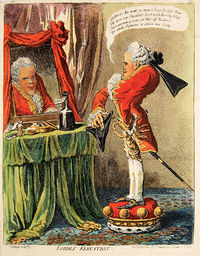Annotation:Lord Spindle: Difference between revisions
(Created page with "'''Back to [[{{BASEPAGENAME}}]]''' ---- <p><font face="garamond, serif" size="4"> '''LORD SPINDLE.''' English, Country Dance Tune (whole time). G Major. Standard tuning (fiss...") |
m (Text replacement - "garamond, serif" to "sans-serif") |
||
| (2 intermediate revisions by one other user not shown) | |||
| Line 1: | Line 1: | ||
'''Back to [[{{BASEPAGENAME}}]]''' | '''Back to [[{{BASEPAGENAME}}]]''' | ||
---- | ---- | ||
<p><font face=" | <p><font face="sans-serif" size="4"> | ||
'''LORD SPINDLE.''' English, Country Dance Tune (whole time). G Major. Standard tuning (fisslw). AABB. The melody is unique to Charles and Samuel Thompson's Compleat Collection, vol. 3 (London, 1773). Lord Spindle was the name of a stock character in 18th century literature, representative of the leisure class or aristocracy. He is mentioned, for example, in Richard Sheridan's play '''School for Scandal''' (1777), along with Lady Frizzle, the Dowager Lady Dundizzy, and Captain Quinze; and in Laurence Sterne and John Hall-Stevenson's '''A Sentimental Journey Through France and Italy''' (1774). | '''LORD SPINDLE.''' English, Country Dance Tune (whole time). G Major. Standard tuning (fisslw). AABB. The melody is unique to Charles and Samuel Thompson's Compleat Collection, vol. 3 (London, 1773). Lord Spindle was the name of a stock character in 18th century literature, representative of the leisure class or aristocracy. He is mentioned, for example, in Richard Sheridan's play '''School for Scandal''' (1777), along with Lady Frizzle, the Dowager Lady Dundizzy, and Captain Quinze; and in Laurence Sterne and John Hall-Stevenson's '''A Sentimental Journey Through France and Italy''' (1774). | ||
[[File:strange.jpg|200px|thumb|left|The balloon reads: "Me thinks I'm now a marv'lous proper Man, I'll have my Chambers bin'd with Looking Glass, And entertain a score or two of Tailors, To study Fashions to adorn my body". A caricature by James Gillray (1757 - 1815)]] | |||
<br> | <br> | ||
<br> | <br> | ||
</font></p> | </font></p> | ||
<p><font face=" | <p><font face="sans-serif" size="4"> | ||
''Source for notated version'': | ''Source for notated version'': | ||
<br> | <br> | ||
<br> | <br> | ||
</font></p> | </font></p> | ||
<p><font face=" | <p><font face="sans-serif" size="4"> | ||
''Printed sources'': Thompson ('''Compleat Collection of 200 Favourite Country Dances, vol. 3'''), 1773; No. 102. | ''Printed sources'': Thompson ('''Compleat Collection of 200 Favourite Country Dances, vol. 3'''), 1773; No. 102. | ||
<br> | <br> | ||
<br> | <br> | ||
</font></p> | </font></p> | ||
<p><font face=" | <p><font face="sans-serif" size="4"> | ||
''Recorded sources'': <font color=teal></font> | ''Recorded sources'': <font color=teal></font> | ||
</font></p> | </font></p> | ||
Latest revision as of 14:17, 6 May 2019
Back to Lord Spindle
LORD SPINDLE. English, Country Dance Tune (whole time). G Major. Standard tuning (fisslw). AABB. The melody is unique to Charles and Samuel Thompson's Compleat Collection, vol. 3 (London, 1773). Lord Spindle was the name of a stock character in 18th century literature, representative of the leisure class or aristocracy. He is mentioned, for example, in Richard Sheridan's play School for Scandal (1777), along with Lady Frizzle, the Dowager Lady Dundizzy, and Captain Quinze; and in Laurence Sterne and John Hall-Stevenson's A Sentimental Journey Through France and Italy (1774).

Source for notated version:
Printed sources: Thompson (Compleat Collection of 200 Favourite Country Dances, vol. 3), 1773; No. 102.
Recorded sources:
Back to Lord Spindle
